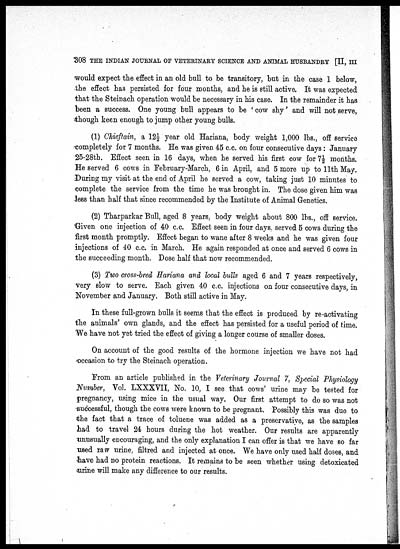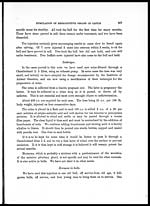Medicine - Veterinary > Veterinary colleges and laboratories > Indian journal of veterinary science and animal husbandry > Volume 2, 1932 > Original articles > Note on the stimulation of the reproductive organs of cattle
(357) Page 308
Download files
Individual page:
Thumbnail gallery: Grid view | List view

308 THE INDIAN JOURNAL OF VETERINARY SCIENCE AND ANIMAL HUSBANDRY [II, III
would expect the effect in an old bull to be transitory, but in the case 1 below,
the effect has persisted for four months, and he is still active. It was expected
that the Steinach operation would be necessary in his case. In the remainder it has
been a success. One young bull appears to be ' cow shy' and will not serve,
though keen enough to jump other young bulls.
(1) Chieftain, a 12½ year old Hariana, body weight 1,000 lbs., off service
completely for 7 months. He was given 45 c.c. on four consecutive days: January
25-28th. Effect seen in 16 days, when he served his first cow for 7½ months.
He served 6 cows in February-March, 6 in April, and 5 more up to 11th May.
During my visit at the end of April he served a cow, taking just 10 minutes to
complete the service from the time he was brought in. The dose given him was
less than half that since recommended by the Institute of Animal Genetics.
(2) Tharparkar Bull, aged 8 years, body weight about 800 lbs., off service.
Given one injection of 40 c.c. Effect seen in four days served 5 cows during the
first month promptly. Effect began to wane after 8 weeks and he was given four
injections of 40 c.c. in March. He again responded at once and served 6 cows in
the succeeding month. Dose half that now recommended.
(3) Two cross-bred Hariana and local bulls aged 6 and 7 years respectively,
very slow to serve. Each given 40 c.c. injections on four consecutive days, in
November and January. Both still active in May.
In these full-grown bulls it seems that the effect is produced by re-activating
the animals' own glands, and the effect has persisted for a useful period of time.
We have not yet tried the effect of giving a longer course of smaller doses.
On account of the good results of the hormone injection we have not had
occasion to try the Steinach operation.
From an article published in the Veterinary Journal 7, Special Physiology
Number, Vol. LXXXVII, No. 10, I see that cows' urine may be tested for
pregnancy, using mice in the usual way. Our first attempt to do so was not
successful, though the cows were known to be pregnant. Possibly this was due to
the fact that a trace of toluene was added as a preservative, as the samples
had to travel 24 hours during the hot weather. Our results are apparently
unusually encouraging, and the only explanation I can offer is that we have so far
used raw urine, filtred and injected at once. We have only used half doses, and
have had no protein reactions. It remains to be seen whether using detoxicated
urine will make any difference to our results.
Set display mode to: Large image | Zoom image | Transcription
Images and transcriptions on this page, including medium image downloads, may be used under the Creative Commons Attribution 4.0 International Licence unless otherwise stated. ![]()
| Permanent URL | https://digital.nls.uk/75228286 |
|---|
| Description | Covers articles from 1932. |
|---|




